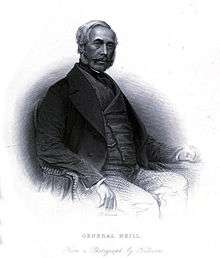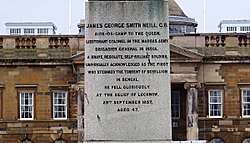James George Smith Neill
James George Smith Neill (27 May 1810 – 25 September 1857)[1] was a Scottish military officer of the East India Company, who served during the Indian rebellion of 1857. He was infamous for the indiscriminate killing of native Indians in revenge for the murder of British women and children during the Bibighar massacre. His father was Colonel Neill.[1]
James Neill | |
|---|---|
 | |
| Born | 27 May 1810 Swindridgemuir, Scotland |
| Died | 25 September 1857 (aged 47) Lucknow, British India |
| Allegiance | |
| Service/ | Madras Army |
| Years of service | 1827–1857 |
| Rank | Brigadier-General |
| Battles/wars | Second Burmese War Crimean War Indian Rebellion of 1857 |
Early career
Neill was born at Swindridgemuir, near Dalry, Scotland and educated at the University of Glasgow. Entering the service of the British East India Company in 1827, he received his lieutenant's commission a year later. From 1828 to 1852 he was mainly employed in duty with his regiment, the 1st Madras Europeans (of which he wrote a Historical Record), but gained some experience on the general and the personal staffs as D.A.A.G. and as aide-de-camp. In 1850 he received his majority, and two years later set out for the Second Burmese War with the regiment. He served throughout the war with distinction, became second-in-command to Cheape, and took part in the minor operations which followed, receiving the brevet of lieutenant-colonel. In June 1854 he was appointed second-in-command to Sir Robert Vivian to organize the Turkish contingent for the Crimean War.
1857 Uprising
Early in 1857 he returned to India. Six weeks after his arrival came the news that all northern India was aflame with revolt (see the Indian rebellion of 1857). Neill acted promptly; he left Madras with his regiment at a moment's notice, and proceeded to Benares. As soon as he arrived on 3 June, he preemptively disbanded the local native regiment. A regiment of Sikhs stationed at Varanasi, normally considered 'loyal', revolted. They fled after Neill's commanders shot at them, but returned to duty later.[2]
On 9 June, General Neill set out for Allahabad, where a handful of Europeans still held out in the fort against the rebels. General Neill ordered hanging of those suspected of being the mutineers.[3] According to one of his officers, he also allowed his soldiers to kill the "native" people without due process and burn them from their houses.[4] His Sikh forces stationed at Jaunpur revolted upon seeing these massacres.[2] From 6 to 15 June his men forced their way under conditions of heat and of opposition. Neill received his reward in an army colonel and appointment and aide-de-camp to the queen.
Allahabad was soon made the concentration of Henry Havelock's column. Neill then turned to the besieged city of Kanpur. Following the Bibighar massacre of British women and children at Kanpur, General Neill indulged in indiscriminate killings of Indians. He personally executed many of his prisoners. In one episode, he compelled randomly rounded up Brahmins from Kanpur, who had nothing to do with the event, to wash up the blood of the Bibighar victims from the floor, an act that presumably degraded them with loss of caste, while they were whipped till they collapsed with cat-o-nine-tails by young ensigns. They were then summarily executed by hanging.[5]
Meanwhile, Havelock, in spite of a succession of victories, had been compelled to fall back for lack of men; Neil criticized his superior's action. A second expedition had the same fate, and Neill himself was now attacked, though by his own exertions and Havelock's victory at Bithor (16 August) the tension on the communications was ended. Havelock's men returned to Cawnpore, and cholera broke out there, whereupon Neill again committed himself to criticisms, this time addressed to the commander-in-chief and to Outram, who was on the way with reinforcements.
In spite of his acts of insubordination, Havelock gave his rival a brigade command in the final advance. The famous march from Cawnpore to Lucknow began on 18 September; on the 21st there was a sharp fight; on the 22nd incessant rain; on the 23rd intense heat. On the 23rd, the fighting opened with the assault on the Alum Bagh, Neill at the head of the leading brigade, exposing himself. The next day he was again heavily engaged, and on the 25th he led the attack on Lucknow itself. His men were entering the city when their commander was suddenly killed in action at Lucknow, shot in the head at Khas Bazaar on 25 September 1857.
Memorials

The rank and precedence of the wife of a K.C.B. was given to his widow, and memorials have been erected in Lucknow and at Ayr. Memorial at the Residency, Lucknow reads - "Sacred to the memory of Brigadier General J.G.S. Neill A.D.C. to the Queen. Col J.L. Stephenson c.o. Major S.G.C. Renaud Lieut. W.G. Groom. Lieut N.H. Arnold. Lieut A.A. Richardson. Lieut J.A. Chisholm Lieut F. Dobbs 352 non-commissioned officers, drummers and rank and file of the First Madras Fusiliers who fell during the suppression of the rebellion in Bengal 1857-58."
Neill was commemorated by the British who named a prominent area in Lucknow as "Neill Lines". An island in the Andamans was named after him, as a mark of honour and now Neill Island (or Neil Island).
See also
- Neil statue satyagraha
References
- Dictionary of Indian Biography p314
- George Bruce Malleson (1891). The Indian Mutiny of 1857. Seely and Company, Limited. pp. 181–184. Retrieved 13 August 2013.
- Pramod K. Nayar (2007). The Penguin 1857 Reader. Penguin Books India. p. 13. ISBN 978-0-14-310199-4. Retrieved 13 August 2013.
- Heather Streets (2004). Martial Races: The Military, Race and Masculinity in British Imperial Culture. Manchester University Press. p. 39. ISBN 978-0-7190-6962-8.
- Illustrated London News, 26 September 1857. See C. Hibbert, The Great Mutiny: India 1857(London 1978) for further discussion,
- J. W. Kaye, Lives of Indian Officers (1889)
- J. C. Marshman, Life of Havelock (1867).
